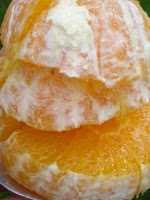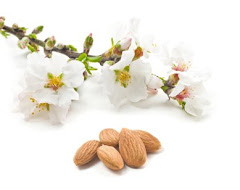Don't get me wrong - I've enjoyed eating (and making) a lot of raw cacao (mostly in the form of raw chocolate) since going raw. My family's enjoyed it too, and I'm sure it's helped lots of people ease into raw food ('you mean I can still eat chocolate?'). I've made raw chocolate at RawforLife classes, and, if you offered me some tomorrow...I think I might eat it!
But, there are these nagging things...
Can it really be classed as raw? The beans don't taste good in their natural state and, to get the chocolatey flavour, have to be piled up to ferment. They can get quite hot, and even though we're told they're turned regularly, can we really be sure the beans are kept below the 118 F cut-off point that's generally deemed to be the point at which enzymes and nutrients are preserved?
Is the 'high' it gives us (and it does) really good for our bodies in the long term? ('Natural Hygiene' says that stimulants create euphoria because our bodies are on 'all systems go' trying to eliminate a toxic invader.) My experience is there is often 'pay-back' later (tiredness) after raw chocolate.
How 'natural' are raw chocolate bars when cacao butter (the fat of the bean only) and chocolate powder (the bean less the fat) are combined into a concoction that has much higher fat than the natural food?
When it comes down to it, although I do love the taste of raw chocolate, there are just a few too many 'what-ifs' about cacao, and I don't find this happening with my other raw foods...
Enter the Carob
I remember carob in the Seventies/Eighties; it was marketed as a 'chocolate substitute', but, to me, on a standard cooked diet then, a 'healthy' carob bar, compared with a Mars Bar - just didn't cut it for me!
But, now, 30 years later, as my love affair with chocolate, and even raw cacao, has cooled a little, I find the unassuming carob, overlooked in favour of the flashier cacao, strangely attractive; I find myself using it more and more, and popped a carob pod into the recent RawforLife class goodie bags (along with the chocolate...)
What is the Carob?
 It's a seed pod, from the carob tree. The carob tree is a real toughie (carobs are often planted close to homes to slow down grass fires), and it loves drought (so unfortunately not suitable for the UK). The carob, which can grow huge (up to 50 ft tall) is native to the Mediterranean and grown in countries such as Spain, Portugal, Italy, Greece, Turkey, Egypt, and in lots of other parts of the world with a similar climate (eg some parts of the USA and Australia). In fact, I've read that in Southern California young carob trees are classed as 'one of the worst weeds'! I know I have some Californian readers. Can't be true, surely...(and wouldn't carobs be rather helpful in a forest fire?)
It's a seed pod, from the carob tree. The carob tree is a real toughie (carobs are often planted close to homes to slow down grass fires), and it loves drought (so unfortunately not suitable for the UK). The carob, which can grow huge (up to 50 ft tall) is native to the Mediterranean and grown in countries such as Spain, Portugal, Italy, Greece, Turkey, Egypt, and in lots of other parts of the world with a similar climate (eg some parts of the USA and Australia). In fact, I've read that in Southern California young carob trees are classed as 'one of the worst weeds'! I know I have some Californian readers. Can't be true, surely...(and wouldn't carobs be rather helpful in a forest fire?)The ripe pods fall to the ground and are eaten by various mammals, including us. Here are some carob pods my son, Joe, found wild in Spetses, Greece, just two days ago. He snaffled a small number home, not to propagate I stress, but for me to eat!
The pods are quite hard, but easily chewable for most, with a softer and sweet interior, which surrounds beans which are so hard that it's definitely best to discard them, unless your aim is to have them pass straight through you and then into the ground (which of course would be ideal..).

What do they taste like? Sweet, vaguely chocolatey (but taste-wise it's probably best to assess carob in its own right rather than compare it with something it's not), reminiscent of banana (I think) and, altogether, very good!
I'd been keen to experience the fresh, as previously the only raw carob pods I'd eaten had been those sold by the online raw stores. I'd imagined the fresh would be much softer, but in fact, there's very little difference. The fresh and the packaged -both quite chewy! As with anything, the fresh does taste best, but I'd say that the packaged pods are still good in comparison.
 I normally buy my carob pods from Detox Your World. Theirs come from Turkey, and are collected from wild trees. Sometimes (not always, and perhaps it's to do with age) there's a faint cheesy taste on first bite, but that soon changes to sweetness.
I normally buy my carob pods from Detox Your World. Theirs come from Turkey, and are collected from wild trees. Sometimes (not always, and perhaps it's to do with age) there's a faint cheesy taste on first bite, but that soon changes to sweetness. History
There are references to carob-eating going back thousands of years. For example, we know it was eaten in Ancient Egypt. It was the most widely-used source of sugar until sugarcane became popular, and there are accounts of thousands crediting their survival in wartime on the carob pod.
The Bible says that John the Baptist lived on honey and locusts. In fact, it's thought by many that something got lost in translation here, and that the reference to 'locusts' should have been 'locust beans' (another name for the carob). And in fact a common name for the carob tree is Saint John's Bread.
So, if we are to believe these accounts of people living soley (or almost solely?) on carob, then surely carob should be classed as a... superfood! Detoxyourworld does describe carob pods as 'nutrient dense' (and more on that later). Just after World War II, when chocolate and sweets were hard to come by, markets in the UK were selling carob pods to schoolchildren to chew on - wonder if they realised how lucky they were!
Carob in raw food recipes
Many raw food recipe books feature carob, most often in smoothies, desserts and cakes, and carob can be substituted for cacao in many recipes. The best form of carob to use in raw food prep is carob powder, and if we buy 'raw carob' from reputable online stores we can be sure that it has been processed at a sufficiently low temperature to protect nutrients (standard health shop carob powders have often been heated to as high as 200F).

I've been making this smoothie a lot recently (makes two big glasses - enough for two, or one greedy me).
- 3-4 spotty bananas
- 2 chopped dates (soak first if ordinary blender)
- 1 tbsp raw carob powder
Apparently, carob has been used to make dog treats, so, if you have a raw pet, see what you can come up with!
Carob or Cacao?
Well, I've suggested carob should be assessed in its own right, but inevitably comparisons will be drawn, so..
Taste? No, it doesn't really taste like chocolate - just a bit like it. But it still tastes good.
Like cacao, it contains a whole range of nutrients: Vitamins A, B1, B2, calcium, magnesium, potassium and trace minerals iron, copper and others. It doesn't contain as much magnesium as cacao, but does contain three times the calcium.
The carob pod is sweeter than the fermented cacao bean. It contains around 45% sugar, whilst cacao contains 5%. This makes carob a good source of carbohydrates, giving simple sugars which provide fuel and are digested easily. For cacao to be as sweet as carob, sweeteners need to be added, such as the 'debatably-raw' agave nectar.
Carob has lower fat (7%) than cacao (23%). As some notables in the raw food world (eg Dr Doug Graham) believe that sugar problems are linked to fat in the blood, it's good to see that the high sugar in carob is to some extent balanced by the low fat.
Carob contains neither caffeine nor theobromine, the two most controversial substances in cacao.
And, to summarise, there is no reason to have the slightest twinge of doubt as to whether carob is a good thing to eat.
No contest really.





















